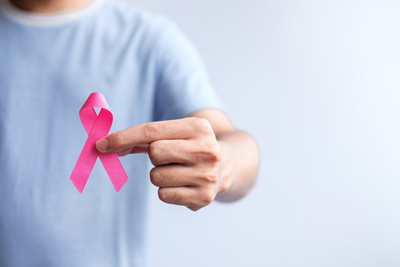Nersan Govender (61) of Killarney, Johannesburg, was stunned when what he thought was a pimple on his chest turned out to be male breast cancer. He describes his ordeal and how he wants to raise awareness of the disease.
I was in Sweden in May 2013, working in the public-interest law/human rights space, when I discovered a “spot” on my chest, just beneath the left nipple. I went to the chemist and was given some hydrochloric cream, but it didn’t go away – instead, it grew into a pimple.
When I got back to South Africa, I went to get it checked out and was told I needed to have a mammogram, which was an experience, as the machines aren’t designed for males.
After much squeezing and pushing, the test was done. The doctor was concerned about the results and said I should have a biopsy. When the results came back, her words made my blood run cold. She said, “Do you have a strong support structure?”
The cancer was aggressive, and my lump needed to come out as soon as possible. Breaking the news to my family was hard, especially for my sons. For their sake I tried to downplay it and reassure them that everything would be okay. But the truth was I really didn’t know.
Breast cancer treatment
I was booked for surgery on 24 June – three days after my diagnosis – and had a mastectomy to remove my left breast. The operation went well, and I was discharged two days later. I was then referred to an oncologist, who was happy with the histopathology report on the tumour that had been removed. However, he was concerned about the recurrence rate.
He recommended further investigation of the tumour to determine if I needed chemotherapy and while we waited for the results, I started radiation. I met other cancer patients, and we shared our stories. I also joined the Wings of Hope Cancer support group, which played a huge role in helping me deal with my cancer and treatment.
Then the results of the tests on the tumour came back and the doctor’s concerns were confirmed: the chance of it recurring was high and I needed chemo – 16 sessions in all.
Chemotherapy hell
Chemo was hell. I was put on the cocktail Adriamycin, otherwise known as the red devil, and to put it simply, death is a better option. You feel paralysed by exhaustion, everything tastes metallic, and you have a constant chemical smell. There’s also brain fog. Everything became a blur – I couldn’t read, listen to, or watch TV. All I could do was concentrate on surviving.
When I had enough energy, I’d go to work and spend time in my garden, which became my solace. The treatment took its toll on my marriage, which isn’t unusual – people often can’t cope when their partner has cancer. They leave, and that’s just the way it is.
But my relationship with my sons, who are 30 and 27 now, grew even stronger and I became closer to my younger sister, who’s a breast cancer survivor too. My older sister also had breast cancer but interestingly, there’s no genetic link between our cancers. We had the tests done, and nothing. It was just a very unfortunate coincidence.
Breast cancer survivor
I’ve been cancer-free now for 10 years. Dr Owen Nosworthy at the Wits Donald Gordon Medical Centre is my maintenance oncologist. I go for tests once a year to check my markers but so far, so good.
I am now the chairperson of Wings of Hope and a member of Momentum Force, a group of experts geared towards giving breast cancer-related advice to men across the country.
There’s not enough awareness about male breast cancer – it’s still regarded as a woman’s disease and there’s a stigma around it. You get insulted – I was called things like “half a woman”, and people look at you strangely.
In many ways, I was one of the lucky ones: men with breast cancer are often diagnosed too late and the survival rate in men is less than 7%. Every year I celebrate two birthdays: the date of my birth in July and 21 June 2013, the date I was diagnosed. That’s my life birthday. I was given a second chance. I’m a male breast cancer survivor.
Male breast cancer facts
- 1% of people with breast cancer are men.
- Genes and family history, including faulty versions of the genes BRCA1 or BRCA2, increase the risk.
- Conditions that can increase the level of oestrogen, including obesity and scarring of the liver, can result in male breast cancer.
- Klinefelter syndrome, a genetic error where a male is born with an extra copy of the X chromosome, can trigger breast cancer.
- Signs of male breast cancer include a lump or swelling in the breasts or armpit, redness or flaky skin on the breast, irritation or dimpling of the skin, nipple discharge and indentation of the nipple or pain in the nipple.
Disclaimer: The information provided in this article was correct at the time of publishing. At Mediclinic we endeavour to provide our patients and readers with accurate and reliable information, which is why we continually review and update our content. However, due to the dynamic nature of clinical information and medicine, some information may from time to time become outdated prior to revision.

